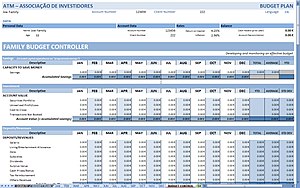A personal budgets (for the budget of one person) or household budget (for the budget of one or more people living in the same dwelling) [1] is a plan for the coordination of the resource (income) and expenses of an individual or a household. [2]
A personal budgets (for the budget of one person) or household budget (for the budget of one or more people living in the same dwelling) [1] is a plan for the coordination of the resource (income) and expenses of an individual or a household. [2]
Personal budgets are usually created to help an individual or a household of people to control their spending and achieve their financial goals. [3] Having a budget can help people feel more in control of their finances and make it easier for them to not overspend and to save money. [4] [5] People who budget their money are less likely to amass large debts, are more likely to lead comfortable lives in retirement, and are better prepared for emergencies. [6]
In the most basic form of creating a personal budget the person needs to calculate their net income, track their spending over a set period of time, set goals based on the information previously gathered, make a plan to achieve these goals, and adjust their spending based on the plan. [4] There exist many methods of budgeting to help people do this. [7]
This method involves assessing one's financial situation, setting realistic financial goals, allocating income, tracking spending and adjusting the budget, and regularly reviewing and revising the budget. These steps can help individuals gain better control over their finances and achieve their financial goals. [8]
The 50/30/20 budget is a simple plan that sorts personal expenses into three categories: "needs" (basic necessities), "wants", and savings. 50% of one's net income then goes towards needs, 30% towards wants, and 20% towards savings. [9] [7]
In the pay yourself first budget people first save at least 20% of their net income, and then freely spend the remaining 80%. They can also choose a 70/30, 60/40, or 50/50 budget for more savings. The most important part of this method is to put one's savings apart before spending on anything else. [7] [10]
This method is a variation of the pay yourself first budget, in which people create multiple savings accounts, each for one specific goal (such as a vacation or a new car), and each with an amount of money that should be reached by a specific date. They then divide the amount of money needed by the timeline to calculate how much they should save each month. [7]

For this method, people need to use cash instead of debit or credit cards. They need to allocate their net income into categories (e.g. groceries), withdraw the cash allocated for each category, and put them into envelopes. Any time they want to buy something in one of the categories, they only take the designated envelope so that they cannot overspend. [11]
In zero-based budgeting, all of one's net income must be allocated ahead of spending. [11] Zero-based budgeting involves dividing income into different expense categories, ensuring that all funds have been assigned a purpose, and at the end of the month there is a zero balance in the budget. [12]
Several personal finance softwares and mobile apps have been developed to help people with managing their money. Some of them can be used for budgeting and expense tracking, others mainly for one's investment portfolio. There are both free and paid options. [13]

Within the budgetary process, deficit spending is the amount by which spending exceeds revenue over a particular period of time, also called simply deficit, or budget deficit: the opposite of budget surplus. The term may be applied to the budget of a government, private company, or individual. Government deficit spending was first identified as a necessary economic tool by John Maynard Keynes in the wake of the Great Depression. It is a central point of controversy in economics, as discussed below.
A regressive tax is a tax imposed in such a manner that the tax rate decreases as the amount subject to taxation increases. "Regressive" describes a distribution effect on income or expenditure, referring to the way the rate progresses from high to low, so that the average tax rate exceeds the marginal tax rate.

The government budget balance, also referred to as the general government balance, public budget balance, or public fiscal balance, is the difference between government revenues and spending. For a government that uses accrual accounting the budget balance is calculated using only spending on current operations, with expenditure on new capital assets excluded. A positive balance is called a government budget surplus, and a negative balance is a government budget deficit. A government budget presents the government's proposed revenues and spending for a financial year.

Personal finance is the financial management that an individual or a family unit performs to budget, save, and spend monetary resources in a controlled manner, taking into account various financial risks and future life events.

A budget is a calculation plan, usually but not always financial, for a defined period, often one year or a month. A budget may include anticipated sales volumes and revenues, resource quantities including time, costs and expenses, environmental impacts such as greenhouse gas emissions, other impacts, assets, liabilities and cash flows. Companies, governments, families, and other organizations use budgets to express strategic plans of activities in measurable terms.
A tax cut represents a decrease in the amount of money taken from taxpayers to go towards government revenue. Tax cuts decrease the revenue of the government and increase the disposable income of taxpayers. Tax cuts usually refer to reductions in the percentage of tax paid on income, goods and services. As they leave consumers with more disposable income, tax cuts are an example of an expansionary fiscal policy. Tax cuts also include reduction in tax in other ways, such as tax credit, deductions and loopholes.

A taxpayer is a person or organization subject to pay a tax. Modern taxpayers may have an identification number, a reference number issued by a government to citizens or firms.

Consumer spending is the total money spent on final goods and services by individuals and households.

The United States budget comprises the spending and revenues of the U.S. federal government. The budget is the financial representation of the priorities of the government, reflecting historical debates and competing economic philosophies. The government primarily spends on healthcare, retirement, and defense programs. The non-partisan Congressional Budget Office provides extensive analysis of the budget and its economic effects. CBO estimated in February 2024 that Federal debt held by the public is projected to rise from 99 percent of GDP in 2024 to 116 percent in 2034 and would continue to grow if current laws generally remained unchanged. Over that period, the growth of interest costs and mandatory spending outpaces the growth of revenues and the economy, driving up debt. Those factors persist beyond 2034, pushing federal debt higher still, to 172 percent of GDP in 2054.
Aggregate income is the total of all incomes in an economy without adjustments for inflation, taxation, or types of double counting. Aggregate income is a form of GDP that is equal to Consumption expenditure plus net profits. 'Aggregate income' in economics is a broad conceptual term. It may express the proceeds from total output in the economy for producers of that output. There are a number of ways to measure aggregate income, but GDP is one of the best known and most widely used.
Retirement planning, in a financial context, refers to the allocation of savings or revenue for retirement. The goal of retirement planning is to achieve financial independence.
You Need a Budget (YNAB) (pronounced ) is a privately owned American company that develops an online personal budgeting program based on the envelope system. It is available via any internet browser or a mobile app. The program was initially developed as standalone software in 2004 by Jesse Mecham, while he was in college pursuing his master's degree in accounting after an experience where he and his wife had no money and needed to improve their budgeting. It evolved from a spreadsheet that he created for the budgeting process. In, 2015, they changed their licensing model to Software as a service.

In accounting, reconciliation is the process of ensuring that two sets of records are in agreement. It is a general practice for businesses to create their balance sheet at the end of the financial year as it denotes the state of finances for that period. Reconciliation is used to ensure that the money leaving an account matches the actual money spent. This is done by making sure the balances match at the end of a particular accounting period.

Overspending is spending more money than one can afford. It is a common problem when easy credit is available. The term overspending is also used for investment projects when payments exceed actual calculated cost.
The envelope system, also known as the envelope budgeting method or cash stuffing, is a popular method for visualizing and maintaining a flexible budget. The key idea is to prioritize cash income to meet separate categories of household expenses in physically separate envelopes.

The sectoral balances are a sectoral analysis framework for macroeconomic analysis of national economies developed by British economist Wynne Godley.
A balance sheet recession is a type of economic recession that occurs when high levels of private sector debt cause individuals or companies to collectively focus on saving by paying down debt rather than spending or investing, causing economic growth to slow or decline. The term is attributed to economist Richard Koo and is related to the debt deflation concept described by economist Irving Fisher. Recent examples include Japan's recession that began in 1990 and the U.S. recession of 2007-2009.
This glossary of economics is a list of definitions of terms and concepts used in economics, its sub-disciplines, and related fields.

Squirrel was a British company that provided an online personal budgeting service. The company claimed that it had several thousand users in the United Kingdom. It was described by Liat Clark in Wired magazine as a "total savings, budgeting and bill management tool".
The FIREmovement is a lifestyle movement with the goal of gaining financial independence and retiring early. The model became particularly popular among millennials in the 2010s, gaining traction through online communities via information shared in blogs, podcasts, and online discussion forums.